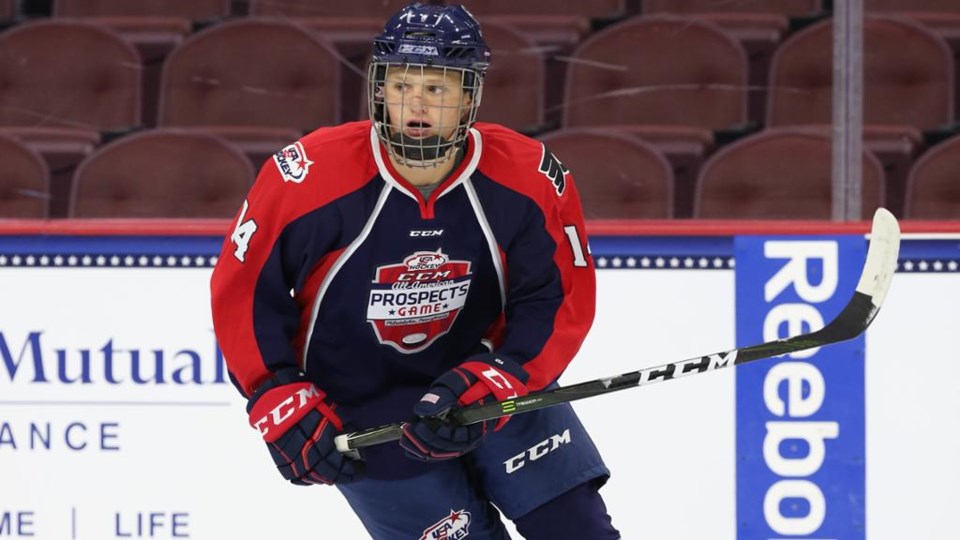It’s easy to become paralyzed by the sheer number of options the Canucks will have with the fifth overall pick. Even just limiting the list to centres, like they probably should, results in a plethora of possibilities: Cody Glass, Elias Pettersson, and Gabriel Vilardi would all make sense for the Canucks.
But there’s one other centre the Canucks will have to consider, assuming they don’t go with a more off-the-board option like Michael Rasmussen or Martin Necas. That centre is Casey Mittelstadt, who is one of the most dynamic and skilled players available in the 2017 draft.
Mittelstadt split his season between the USHL and the lesser competition offered by US High School hockey, as he returned to Eden Prairie High in an attempt to win a championship with the teammates he grew up playing with. He was dominant at the high school level, scoring 21 goals and 64 points in 25 games, but it’s hard to know what to make of those numbers.
Fortunately, he also dominated against tougher competition in the USHL and in international competition. He led the USHL in points-per-game, scoring 13 goals and 30 points in 24 games, and racked up points for Team USA at the Ivan Hlinka Memorial Tournament and U-18 World Championship.
Mittelstadt was on the U-18 tournament’s best line with Kailer Yamamoto and Logan Brown, finishing with 4 goals and 9 points in 7 games, then shone again alongside Yamamoto at the Ivan Hlinka, as they both put up 7 points in the 4-game tournament.
Mittelstadt’s unreal skill was on full display at the U-18 tournament, as he used his quick hands and puck control to make defenders and goaltenders look silly at times. His stickhandling might be the best in the draft, particularly because he can handle the puck at top speed. That combination of speed and skill make him dangerous off the rush.
But it’s not just his speed that makes him an excellent skater; it’s his ability to change direction at a moment’s notice to create space or lose a check in the corner. It’s this shiftiness that makes him dangerous once he’s in the offensive zone, as he buys time and space to create scoring chances down low for himself or his teammates.
McKeen’s rates him as the third best playmaker in the draft, behind Vilardi and Nolan Patrick, as he has an ability to find passing lanes that others just don’t see. Combine that playmaking ability with his speed and skill and you can see why scouts project him as a first-line centre.
And that’s not even talking about his shot, which is also very good. He has a quick release on his hard and accurate wrist shot, making him a goalscoring threat from the top of the faceoff circles and in, and he's equally adept at finishing off chances around the net. Essentially, Mittelstadt is the complete package offensively, with no red flags in his defensive play.
There is one red flag, oddly enough, in his offensive play. The majority of his scoring came on the power play, as he put up just 11 of his 30 points at 5-on-5. While he finished first in the USHL in points per game, he was 15th in 5-on-5 points per game.
That has to be a concern, as power play scoring is not as predictive of future success as even-strength scoring. There are reasons to overlook his lack of even-strength success, however.
One is that no one on the Green Bay Gamblers put up a lot of points at even-strength. Mittelstadt still led his team in 5-on-5 points per game. Another is that plenty of top prospects in the USHL rack up power play points; it seems to be a league with a lot of power play scoring. Brock Boeser, for example, had nearly half of his points in his draft year on the power play.
Another concern is his sky-high shooting percentage. His 21.3% shooting percentage was the sixth highest in the USHL last season, and a couple of the players ahead of him had just 22 and 39 shots, so luck really enters into the equation at that point.
But again, there are reasons to look past that sky-high shooting percentage, which would otherwise call into question how much of his scoring came from good fortune: plenty of top prospects post high shooting percentages in the USHL. Jack Eichel, Auston Matthews, Jeremy Bracco, and Sonny Milano all put up shooting percentages north of 20% in the USHL.
The final concern when it comes to Mittelstadt came from the draft combine, where he failed to do a single pull-up and only did one bench-press rep. Clearly, he lacks some upper body strength, even as he did just fine in fitness tests that relate more directly to on-ice performance.
He’s not the first top prospect to fall short at the pull-up station: Sam Bennett famously failed to do a pull-up at his draft combine. It’s a bit more concerning in Mittelstadt’s case, as he’s already 200 lbs, unlike the skinnier Bennett.
That shouldn’t be a huge issue, however, as Mittelstadt is on his way to the University of Minnesota next season, where he’ll have plenty of opportunity to hit the gym and get stronger.
It would make plenty of sense for the Canucks to take Mittelstadt at fifth overall if he’s available. His sublime skill, superb skating, and sweet shot make him a dynamic and exciting player to watch, with legitimate potential to become a first-line forward.



